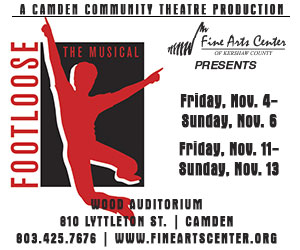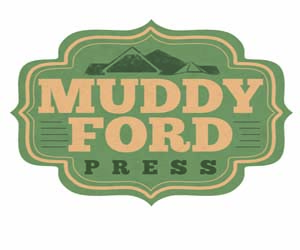Cover Story/Jasper Watches Lyon Hill
By August Krickel
Visual artist. Graphic illustrator. Award-winning indie film maker. Puppeteer. Children’s entertainer. Avant-garde event organizer. Suburban husband and dad. Dark (and vaguely disturbing) visionary. Lyon Hill wears any number of hats, and is one of a growing number of local artists who are able not only to follow and develop their own creative vision, but to make a living doing so here in the Midlands, and attract national attention and acclaim along the way.
A home-grown talent, Hill was born in Columbia, and lived in various locales “on the outskirts of the city,” eventually settling in Swansea, where he finished high school. With his father a painter and art supplies always at hand, art seemed a natural career choice and his family was supportive. “I never really considered anything else, to be honest.” One of his mentors in school was his art teacher, Kiki Ganz. “Her friendship was as valuable as any instruction she gave me, and we still stay in touch.”
After a year at SCAD (the Savannah College of Art and Design) Hill transferred to USC, then did an exchange year at the University of New Mexico. “College had its ups and downs,” Hill admits. “My year in New Mexico had a big impact on my art. I think being absolutely alone and in a beautiful new place brought about a change in my work. I can look at (most of) my work from this point on and not cringe.”
While looking for a summer job in the late ’90s, Hill found his way to the Columbia Marionette Theatre (CMT) and soon realized that he had also found a career. “CMT was in a transition at the time, and they needed artists. I began just puppeteering, but soon was painting backdrops and supplying voices to the characters. As a kid, I liked to entertain my younger sisters with puppets and stuffed animals. I had voices and personalities for a number of them. I had forgotten about this until working at CMT, and the joy of it all came flooding back.” In 2000, CMT founder Allie Scollon retired, her son John took over as Executive Director, and Hill began getting involved in the actual puppet making. “It really clicked, and people seemed to respond to my puppets.” Now the group’s Artistic Director, Hill performs in all the main stage shows, and is usually on the road with traveling shows several times a week. CMT does over 500 performances annually across the state, and beyond; last year included a tour of Slovenia. “We perform at schools, festivals, libraries, churches, and, of course, in our theatre down at Riverfront Park.” They average two new shows each year; Hill makes the puppets, with help and input from John Scollon and his wife Karri (who also creates all the costumes.)
But don’t think he has abandoned traditional drawing. “I’ve been displaying and participating in art ventures in Columbia for about ten years now,” Hill says. “The Art Garage, under Rachel Gibson, is where I first really got some exposure. I gravitate to places that are more informal and have an edge to them. I only display if I have new work, and sometimes other projects (like my films) prevent me from working on anything else for long periods of time.”
Hill’s work isn’t exactly grim, but perhaps it’s Grimm, as in the dark fairy tales. There’s no doubt that the puppet maker’s knowledge of how muscles and joints and tendons fit together to create realistic movement is reflected in the lean, sinewy torsos and limbs that are depicted, often with surreal overtones from fantasy and mythology. One immediately sees similarity with creepy cartoonists like Charles Addams and Edward Gorey, as well as the angular musculature of graphic artists from the Silver Age of comics like Joe Kubert, Neal Adams, Frank Frazetta, and Jim Aparo. Hill concedes that he “always loved comics. Some of my earliest drawings are of Superman. During high school, I started collecting them. Over the years, my tastes have moved beyond superheroes, into more experimental and creator driven comics. The medium has matured quite a bit in the last twenty years, and I am always looking for new and challenging comics. Fantasy movies were also a big influence growing up: Labyrinth, Willy Wonka, and Edward Scissorhands to name a few.” While Tim Burton is certainly an acknowledged influence on Hill, there’s also a touch of William Blake here, a bit of Goya there, along with the starkness of Andrew Wyeth.
The transition into live performance originally wasn’t the most natural thing for Hill. “Coming from a visual art background, I had to come to terms with the fact that a good performance is ephemeral: it happens, it affects people, and it is gone. Videotaping it (to try to preserve it) won’t do it justice either. I have since learned that this quality is what is so special about live performance, and why it can’t be replaced. Making puppets specifically for film has proven to be a great bridge between the two: in creation, it is similar to my process for painting, but it involves performance as well.” In his short films, Hill blurs the lines between two-dimensional and three-dimensional animation; rather than a series of still images that create the illusion of movement, much of Hill’s work involves the actual live manipulation of 2-D drawings and cut-outs, caught on film. “My film work grew organically from working with shadow puppets,” he explains. Heather Henson (the youngest daughter of Jim Henson) was instrumental in encouraging me to develop this new angle. She saw a video I did for fun to celebrate my engagement with Jenny Mae, and picked it up for her film series, Handmade Puppet Dreams. My next film, Incubus, was again for fun, just practicing, and she picked it up, too. She produced my third venture, Junk Palace, and CMT helped provide time and resources. It, too, is in the fourth installment of the HMPD series.
Junk Palace recounts the “true story of the infamous hoarders in New York, the Collyer brothers. It is a tragic story, and I have tried to paint a sympathetic portrait. Jenny came across the story while researching something else. I did a few sketches right then and there and found that it stuck with me over time. The more I read, the more interested I became. It was made entirely with paper puppets, which seemed appropriate for hoarders who collected newspapers, books, and boxes.” For the film version, Hill was assisted by a number of friends, including Robert Padley as lead puppeteer, Steve Daniels on camera, and David Drazin for the score. The film has played around the country at film festivals, “most notably the Newport Beach Film Fest, Full Frame Doc Fest, and our own Indie Grits, where it won the Audience Choice Award” in 2011, as well as the Southern Lens Independent Vision Award. “As part of HMPD, it has screened all across the country and beyond, including Poland and the Czech Republic. Heather has also sent me to Rhode Island School of Design and the University of Central Arkansas to screen and do presentations about the film.”
Hill’s next film project is called Supine, based on a dream that his wife experienced. “It’s been brewing for quite a while now, and receiving a grant from the SC Film Commission and Trident Technical College was the boost it needed to finally see light. This film has a different technique, where my drawings are scanned in to become virtual puppets that are animated in various computer programs. I am working closely with an animator in LA, Jeffrey Shroyer. It is a real learning experience, and I like the results so far. Since it is not a puppet film (my first), it will have to travel in different circles, but I chose this technique because it is a better fit for the subject matter.
Hill explains that “both short films began life as live performances made for puppet slams. I treated these as practice for the films, a chance to work out the story, the visuals, and gauge audience reaction. They are very different in execution from the finished product, and have had a life of their own. Junk Palace Live had a run of performances, and I took it as far as Orlando.” A puppet slam is like a poetry slam, just with puppets, and often performed by experimental artists in non-traditional venues like nightclubs or art spaces. Just a few weeks ago, Hill and colleague Kimi Maeda organized, hosted, and performed in Columbia’s first Spork in Hand Puppet Slam, as part of the 2012 Indie Grits Festival. “Kimi and I are hoping the Puppet Slam will be a success, and we are planting the seeds to make it a recurring event. We know so many talented people who are involved in puppetry, both here in town and beyond, and we want to give them a platform to experiment and push the boundaries of puppetry.”
Up next for Hill is a collaboration between CMT and Trustus Theatre to present Avenue Q, which opens Friday, June 15th. With music and lyrics by Robert Lopez and Jeff Marx, and book by Jeff Whitty, Avenue Q won three Tony Awards, running on Broadway for over six years before moving to off-Broadway, where the show is alive and well and still running today. Avenue Q uses Sesame Street or Muppet-style puppets, which interact with, are given voice by, and are manipulated by live actors, to create a satire of modern society, especially the coming of age of Gen X and the Millenials. Hill is designing the puppets with Karri Scollon taking on construction duties. While the publisher rents out replicas of the Broadway puppets, Director Chad Henderson notes, “Where’s the fun in that? Many cities don’t have a puppet theatre like we do, and they certainly don’t have someone like Lyon. So working with him is allowing us to put a stamp on the Trustus production.”
Hill agrees. “I think it’s great that Trustus wants a unique look for this show. The design is a real challenge for me. You could describe the show as Sesame Street for adults, so I want to preserve a reference to the Muppet look of simple shapes and fabric construction, but to put a unique spin on it. Within the puppet cast, there is a race of monsters, and these are especially fun to design.” Henderson is excited: “I find a kindred spirit in Lyon as an artist – he’s never one to stay inside a box. So we’re having fun discussing all of the possibilities for the characters in this show. We know we’re sticking to the Henson-esque hand puppet that’s been associated with Avenue Q since the beginning, but these will be Lyon’s take on these characters. Did I mention there’s puppet nudity in this show? Well there is – so yep, we’re having fun.”
With this much acclaim, and with his projects now getting exposure worldwide, one wonders if Hill might ever be lured away by Hollywood or New York. Hill is quite content where he is, however, with so many opportunities available right at home. His wife’s success with her line of dolls, Jenny Mae Creations, and their son Oliver, now three, make Columbia all the more attractive. “Having a child has been the best practice for my puppetry skills. We have several puppets at home that Oliver loves to interact with. It’s a real challenge when you don’t have a script. Oliver leads them everywhere, and I do my best to keep up with him.” Hill has an almost infinite number of prospects on the horizon, but says that “I try to follow the direction that my inspiration takes me, be it comics, painting, puppets, or film (or some amalgamation thereof) and my home town is a great proving ground for these ventures. Columbia has always been kind to me, and our family is here to stay.”






.jpg)
